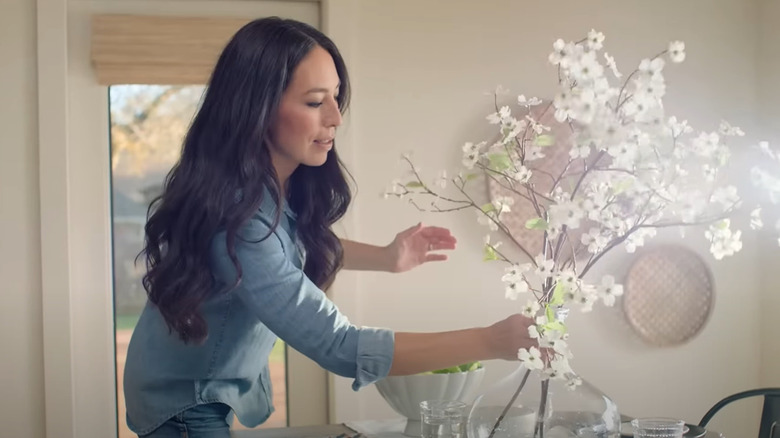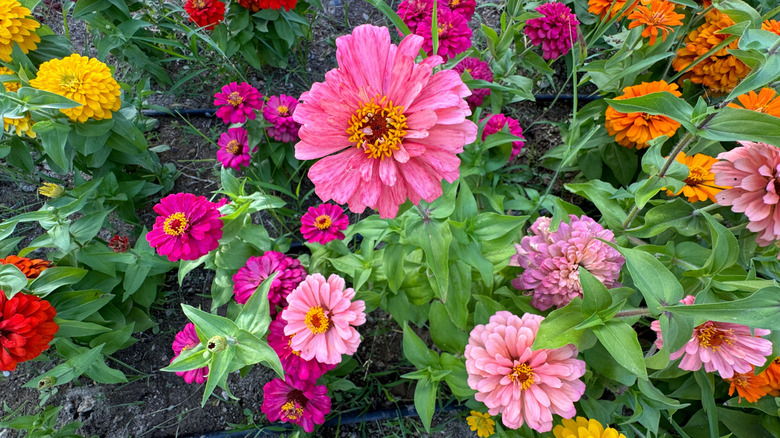Grow Joanna Gaines' Favorite Flowers In Your Own Cutting Garden
Joanna Gaines, co-founder of the Magnolia lifestyle brand and network, loves to spend time in her garden. And if you've ever watched her give design tips for the tabletop or home, fresh flowers are almost always a part of her design strategy. We've got tips on how you can grow Gaines' favorite flowers — including ranunculi, tulips, and zinnias — in your very own cutting garden.
Before planting, Gaines says it's all about planning. She considers symmetry, color, and texture. "I like to print photos of all the flowers in full scale to see how the textures and dimensions will play together, and I'll go off a set color palette to keep everything cohesive," she wrote on her Magnolia blog. So it's a good idea to think about the different shapes of flowers, as well as how their colors and hues will look growing together. Texture is important, too, since sunlight will play on it in the garden. "I'll always delight in the season's harvest and its blooms, but when I think of the garden, I think of the light. The way it kisses the petals good morning and good night," she continued.
When getting started on your cutting garden, it might be best to opt for a raised bed, as Gaines does on the Magnolia Silos property in Waco, Texas. But any of these flower choices could work with whatever gardening space you have available. Soon enough, you'll have a cutting garden full of your favorite flowers, ready to bring inside to spruce up your home.
Growing early-bloomer favorites ranunculus and tulips
Among Gaines' favorite flowers are in the buttercup family, specifically ranunculus and anemone. Ranunculus, an early-blooming perennial, comes in shades of orange, red, white, and pink. When thinking about ranunculus planting, keep in mind that this plant loves moderate, cool spring weather, and prefers to flower when temperatures are between 50 and 75 degrees Fahrenheit. The flowers tend to die back in hotter weather.
Ranunculus doesn't like it too cold, either, though, and will only withstand winters down to USDA Plant Hardiness Zone 7. Anemone are more cold resistant and a little bit hardier. They thrive in zones 4 to 9, and bloom in more colors, including purple, yellow, copper, and blue. Anemones are a no-fuss flower, doing well in both full sunlight and partial shade, and in a variety of soil types including clay, sand, and silt. Of course, keep in mind that anemones and ranunculus, like many buttercup varieties, can be poisonous ... so if you have a pet that likes to munch on garden flowers, steer clear of this one.
Tulips are another on the list of Gaines' favorites for early bloomers. They are among the most cold-hardy flowers on her list of favorites, as they're tolerant to zone 3. Tulips are one of the first flowers to bloom in spring, right alongside daffodils, in many shades like bright yellow, pink, and purple or a combination of blended colors. In the Midwest, tulips bulbs should be planted around October in organic-rich soil.
Dahlias and zinnias are also must-haves for Joanna Gaines
Gaines loves dahlias, too, even though she initially feared they might not thrive in her Texas garden. Dahlias are sensitive to heat – like the heat you'll find in Waco, Texas in the summer — where she grows thousands of flowers at her Magnolia properties. These flowers prefer a mild Texas winter, though, since they're only cold tolerate to zone 7. If you're asking yourself: are dahlias annuals or perennials? The answer is it depends on where you live. If you live in a warmer zone, dahlias act as perennials and will return to bloom again and again. If you live in a zone colder than 7, you'll need to treat them as annuals, or bring them inside before the frost hits.
You won't have to worry about that with zinnias, another Gaines favorite. Zinnias do well in zones as cold as 3 and as warm as 10. They're so versatile, in fact, that they grow in most any soil, as long as they have good sun and decent drainage. This no-fuss flower is a great choice for gardeners just starting out. Zinnias offer beautiful, multi-layered blooms that come in many different shapes, including flowers that look like a bulbous beehive, a cute button, or a spindly cactus. It's no wonder about the variety of blooms, since there are 41 different species of zinnias. They typically grow between 8 inches and 4 feet tall, and deadheading them regularly will encourage more blooms to grow.

